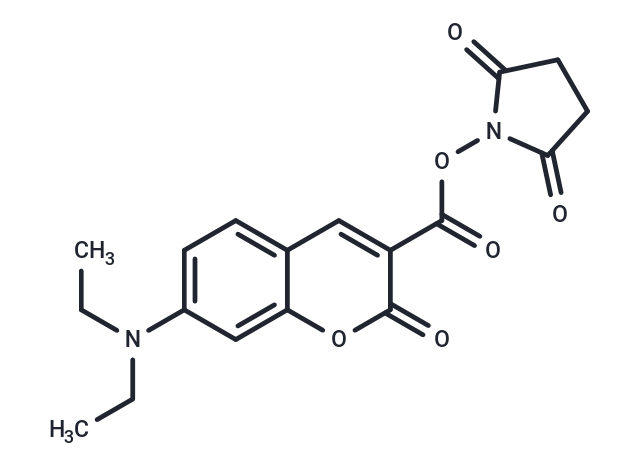Shopping Cart
- Remove All
 Your shopping cart is currently empty
Your shopping cart is currently empty

DEAC, SE can be used for relevant research in the field of life sciences. Its product number is T64949 and CAS number is 139346-57-9.

| Pack Size | Price | Availability | Quantity |
|---|---|---|---|
| 5 mg | $53 | In Stock | |
| 10 mg | $89 | In Stock | |
| 25 mg | $178 | In Stock | |
| 50 mg | $297 | In Stock | |
| 100 mg | $458 | In Stock | |
| 500 mg | $987 | In Stock |
| Description | DEAC, SE can be used for relevant research in the field of life sciences. Its product number is T64949 and CAS number is 139346-57-9. |
| In vitro | Instructions 1. Select solventsDEAC, SE are usually lipophilic molecules, dissolved in anhydrous DMSO or DMF. Note: Ensure that the solvent is anhydrous to avoid premature hydrolysis of the SE group. 2. Sample preparation The biomolecules to be labeled (such as proteins, oligonucleotides) need to be dissolved in an appropriate buffer (such as phosphate buffer at pH 8.3). Note: The protein must contain free amine groups (such as N-terminus or lysine side chains) for coupling. 3. Coupling reaction 1) Slowly add DEAC, SE DMSO solution to the solution (usually 10 times the sample concentration). 2) React at room temperature or slightly below room temperature (4°C) for 1-2 hours, avoiding light. 3) Regulate the pH between 8-9 to ensure the activity of the N-carboximidoester (SE) group. 4. Reaction termination and purification 1) Use buffer to adjust the reaction pH to neutral (7.0) to prevent subsequent spontaneous degradation. 2) Remove unbound DEAC, SE and byproducts by dialysis, gel filtration column (such as Sephadex G-25) or HPLC. 5. Verify labeling Verify labeling efficiency using UV-visible spectrophotometer and fluorescence spectrophotometer. DEAC has a maximum absorption wavelength of ~426 nm; maximum emission wavelength of ~480 nm. Notes 1) Storage conditions: DEAC, SE should be stored in a dry environment at -20°C, away from light and moisture. 2) Optimize the amount used: Adjust the amount of DEAC, SE used according to the characteristics of the target molecule (such as the lysine density of the protein). 3) Avoid cross-reaction: Ensure that there are no free amines in the sample that interfere with labeling. |
| Alias | 7-Diethylaminocoumarin-3-carboxylic acid |
| Molecular Weight | 358.35 |
| Formula | C18H18N2O6 |
| Cas No. | 139346-57-9 |
| Smiles | CCN(CC)c1ccc2cc(C(=O)ON3C(=O)CCC3=O)c(=O)oc2c1 |
| Storage | keep away from direct sunlight | Powder: -20°C for 3 years | In solvent: -80°C for 1 year | Shipping with blue ice/Shipping at ambient temperature. | |||||||||||||||||||||||||
| Solubility Information | DMSO: 10 mg/mL (27.90 mM), Sonication is recommended. | |||||||||||||||||||||||||
Solution Preparation Table | ||||||||||||||||||||||||||
DMSO
| ||||||||||||||||||||||||||

Copyright © 2015-2025 TargetMol Chemicals Inc. All Rights Reserved.